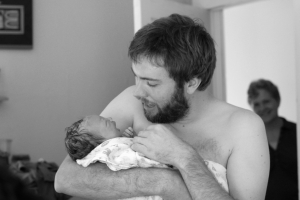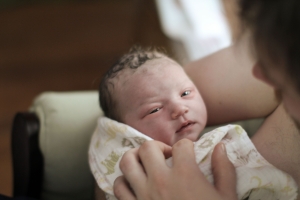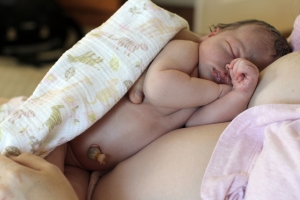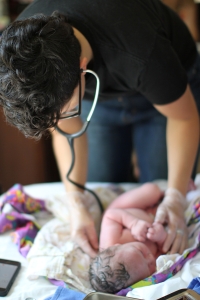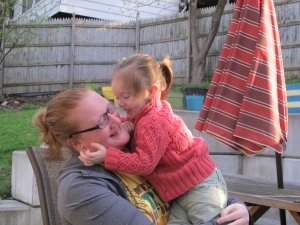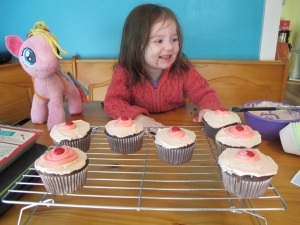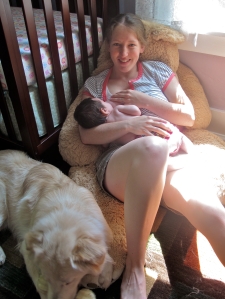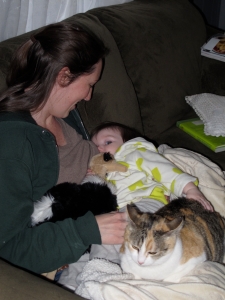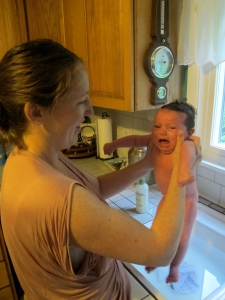Category Archives: Health
The story of Hazel’s birth
On July 30, 2015, probably the hottest day of the year and 3 days past my due date, I was 60lb over my pre-pregnancy weight and desperate for my second baby to be born. Planning a homebirth with Sandra Londino, I asked my midwife to come to my house in the afternoon and strip my membranes, a simple procedure to get your body to produce prostaglandins and encourage labor. This worked to induce labor for my first pregnancy so I was very hopeful that it would work again. I went to bed around 10pm that night and woke up just after 1am starving. Josh helped me downstairs and made me a baked potato, then went back up to bed. I ate, watched some TV and enjoyed some quiet time, but was too restless to go back to bed. By 3am, I started having recognizable contractions, that were a bit uncomfortable but certainly not painful. I woke my husband again to tell him that it was go time!
Josh bustled around the house rounding up the truckload of supplies that we had gathered in anticipation of a homebirth. Then he started to inflate the kiddy pool we bought to serve as a labor tub. I walked around the house very slowly and deliberately, pausing to lean over any high surface (cat tree, countertop, dresser or windowsill) depending on what room I was in. Contractions immediately started coming every 3-4 minutes, just as they did when I was in labor with my firstborn, Evee. The contractions were powerful and required all of my concentration, but I still really didn’t find them very painful. I gave my midwife a quick call just so she knew what was going on, but I asked her to stay at home, knowing that she lived just 2 blocks away and could get here in a flash. With 2-year-old Evee and Janet (Josh’s mom) sleeping, the house was so peaceful that I felt like a confident, competent little elf, working secretly and silently in the middle of the night to make something wonderful.
The intensity of my contractions ramped up steadily, and just before 5am I felt like they had turned a corner. They were incredibly powerful, and that power started to feel like pain, although it was definitely bearable. I asked Josh to call the midwife and tell her to come over. I slipped into the tub set up in my living room, and filled with 100*F water. Ahhhh. The tightness and tension that had been creeping up on me melted away and I felt peaceful again. A few minutes later, Sandra quietly entered my house and Janet woke up and creeped down the stairs to find me laboring in the tub. Although the almost magic quality of the night was interrupted by the arrival of people, everyone whispered and moved slowly, so the calm, secretive peace was preserved.
I asked Sandra to do a quick cervical check to get a baseline for where I was in labor, so she leaned over the tub and slipped her fingers inside me. “Do you feel like pushing at all?” she asked. Definitely not. “Well you’re about 9cm dilated”. Holy cow! I’d made it through almost all of the labor in just over 2 hours, and with surprisingly little pain! By the time I was at this stage with Evee, it had been almost 11 hours, 9 of which were spent gradually (and sometimes not gradually) changing my personal definition of “unbearable pain”.
So I waited quietly in the tub, where my contractions were painful but manageable and my muscles felt deliciously loose in the hot water. I waited for a sign from my body that it was time to meet my precious baby. At the end of my labor with Evee, I felt an incredibly powerful, impossible to ignore desire to push, and the result was an 8lb 5oz little girl after only 20 minutes of pushing. So with Hazel, I knew just what to look for. By 7am, 2 hours of laboring in the tub and wondering when I was going to get that feeling, I was pretty burnt out. The contractions were coming fast and incredibly painful, I was exhausted, and another exam proved that I hadn’t made any progress. What was going on? Why wasn’t Hazel coming?
I decided to get out of the tub, despite my exhaustion, and try to shake her into action. I explored my living room, restlessly looking for a place to stand, or kneel, or move in a way that would get this baby to move down into my birth canal. I spoke with Sandra about breaking my amniotic sac, but she preferred not to disturb the natural process and wanted to wait it out. But I had been in the transition phase for 2 hours, battling ever increasing levels of pain, and there was no change in the baby’s station (how far down she was into the birth canal) or my dilation. I decided to try to take matters into my own hands and see if I could push her down, even though I didn’t feel the urge. I slowly and deliberately climbed my stairs with Josh’s attentive assistance, and decided to sit in the bathroom to try to use the familiar space to try and stimulate a pushing urge.
After 20 minutes of wearing myself out pushing against nothing and making no progress, I felt like I could here my mother’s voice in my head: “The Dr. had to break my sac for both you and Pat; I think we may just have strong sacs.” Broken sac or no, I didn’t feel like I could wait patiently for this baby to descend any longer. I asked Sandra to break my sac, and she told me to lie down on my bed so she could perform the Artificial Rupture Of Membranes. Well, the act of lieing on my back in bed was so incredibly painful, I couldn’t bring myself to stay in that position for more than 1-2 seconds. Every time Sandra came near me with the little crochet-hook-device, I squirmed up in agony onto my knees and said “Just wait for this one to pass”. But it felt like a wall of contractions with no beginning and no end, and I felt terrible for the women compelled to lie on their backs during labor. It was unimaginable torture.
Eventually I managed to lie on my side and lift a leg up for 15-20 seconds so she could break the bag of waters. When it broke, only a little fluid came out, unlike the gush of water that drenched everything when the midwife broke my bag when I was around 7cm dilated with Evee. I imagine this is because I was farther in labor and Hazel’s head was blocking the canal, so most of the water was stuck behind her. However, when the sac ruptured, I felt immediate relief and the contractions slowed down dramatically and were much less painful. Also, right after the rupture, my urge to push finally showed up!! Sandra said I had immediately dilated to 10cm and it was time to have this baby.
I was already in my bed, which had been appropriately covered with protective sheets etc. to make for a clean, contained birth. But after only a moment of trying to push in bed, I felt like I couldn’t get the leverage or the position I needed to be in on the fluffy surface. I climbed out of bed, and poor Sandra, and the nurse Erianna Flores, who were trying to follow me around and predict where I would actually stop and have this baby, went back to moving the chucks pads and supply trays. I squatted on the floor, resting my arms and head on the foot of my bed, and finally felt like I could really push. The floor was so firm, and the bed provided a great spot to grip so I could curl around my huge belly and start pushing this baby down.
Evee had apparently woken about 30 minutes earlier and was happily playing with her grandmother in her room while all this happened. At this point, Janet came into my bedroom with Evee on her hip and I asked Evee if she wanted to stay and watch Hazel’s birth. She said she did and then I beared down to push again. This felt much different than pushing Evee out, Hazel felt like she was much bigger and more stubborn to move, and the feeling of trying to inch her down was incredible. Being in the squatting position and gripping with all of my strength on to the bed for leverage felt like the only way I could possibly make progress. But when I pushed, I sent the bed flying, so Josh asked Janet (still holding Evee on one hip) to stand on the far side of the bed and help hold it in place. Although Hazel’s descent felt incredibly obstructed, I could feel that she was moments (minutes?) away from being born and I felt very lucid. Sandra was positioned behind me, attentive to the birth, and I reminded her that Josh wanted to catch the baby.
Then I pushed with extreme intensity a few more times, making loud grunts and groans. Later I was told that Evee listened to these grunts, wide-eyed, and announced that “Mama is working hard!” I felt the “ring of fire” when it seemed like my birth canal was stretched impossibly wide as Hazel was crowning. This was so intense, that I had assumed I had just pushed Hazel’s head out of my body, and to my shock I heard Josh say that he could see some hair. Why was he just now announcing hair when that whole head had to be hanging out of my body? Although I was confused, I doubled down for some more intense pushing, and after what felt like, to me, the whole body had slipped out, Josh and Sandra announced that the head was out. Although it was painful to be squatting on the floor with a baby only half born, I took a break because I truly felt like my work was over. The urge to push had disappeared instantly and completely, and I couldn’t believe that Hazel wasn’t in my arms yet. But after a few moments, Sandra urged me to keep pushing; Hazel’s head was out but the rest of her body was stuck. In my head, I wondered “really? Shouldn’t she be born now?”, but I listened and tried to push anyways. Unlike the minutes before where pushing felt necessary and instinctive, I couldn’t feel anything, and I didn’t feel like I could get a grip on the baby to actually push. It felt like such a strange situation. As I tried to talk my body into working past quitting time, the atmosphere of the room changed. Because I was so internally focused, I didn’t realize it at first, but everyone was starting to get pretty nervous, and trying to instruct me.
Eventually I made eye contact with Janet, and she was talking to me, trying to help relay the instructions of my midwife. I heard Sandra ask me to stand up and lift my feet up. It was clear that she had already been asking me to do that, but in my haze I hadn’t heard her earlier instructions. I stood up, but my upper body was still curled around my belly because it felt crazy to stand up straight at that point. I think the midwife and nurse were frustrated because it was like trying to communicate to someone who was both blind and deaf, but eventually they made me realize that, although I didn’t want to, yes, indeed, I needed to stand up straight. Erianna got around to my front and started lifting one of my legs up, urging me to lift my knee up to my chest to help the baby come out. Finally I realized what was being asked of me, so I lifted first one knee to my chest, and then the other, in an exaggerated marching move. Once my second knee came up to my chest, Hazel slid right out of my body and into Josh’s arms. Thank God. Born at 7:52 am.
Although I was later told that the environment was noisy and anxious during the 3 minutes that Hazel’s head was out but her shoulders were caught behind my pubic bone (called shoulder dystocia), very little of the loud instruction and emotion had pierced the thick bubble surrounding me, and I would only learn later that we had just pulled through a very serious medical emergency. Josh, who had caught the baby while standing behind me, passed Hazel through my legs and into my waiting arms. I held her tight against my abdomen and carefully sat down on the floor, leaning against the side of the bed. I am told that she was pale and limp and not crying at this point, but I was in a state of shock and honestly didn’t notice. Sandra used a nasal aspirator to clear out Hazel’s nose and mouth while I clutched her to my body, and she immediately started crying, her skin pinked up and all of her muscles firmed. By one minute after birth, Hazel had an Apgar score of 9 out of 10. Everybody seemed to breathe a huge sigh of relief. I wanted to bring Hazel up to my chest, but like Evee, her umbilical cord was quite short and I had to keep her right on my lap. After a few minutes of catching our breath, Sandra noticed that the cord had stopped pulsing and offered to have Josh cut the cord so I could get Hazel into a more comfortable position. My first word after Hazel was born was a quiet but firm “No.” which actually surprised me as much as Sandra. Literally one second later, my body instinctively gave a little push and the placenta flopped out and right onto the floor. It was exactly 8am, meaning that the third stage of my labor was only 8 minutes long.
Josh cut the cord and I was carefully helped into bed to snuggle and nurse my beautiful, perfect little Hazel. About 15 minutes later, Ash and Tommy would show up after driving through the night. A short while after that, our friend Sarah would arrive to take photos of our brand new baby. Poor Janet would spend an eternity scrubbing a placenta-shaped blood stain out of the white rug on our bedroom floor. But for now, I just cuddled my gorgeous girl and thanked God that it was over. She was a 9lb, 1oz, 21 inch long bundle of joy.
Some facts about shoulder dystocia:
Effecting 1 in 200 births, when shoulder dystocia occurs in the hospitals, some obstetricians choose to immediately perform a “generous” episiotomy, cutting through layers of the mother’s tissue not to dislodge the baby, who is actually caught behind bone, but to allow space for the birth attendant to insert his/her hands inside the mother and attempt to twist the baby out. This can result in 4th degree tearing in the mother, potentially leading to a lifetime of incontinence, and 15% of babies will suffer nerve damage in the shoulder, and 10% of babies will suffer a broken collarbone. By “dancing the baby out” instead, I escaped without any tearing whatsoever and Hazel suffered only a bit of bruising from the pressure of her exit. Although I had a bruised tailbone, Hazel and I were spared a hellish recovery.
Homebirth critics will say, sure, a homebirth may be fine until anything goes wrong; but the truth is, homebirth midwives are trained to handle emergency situations, and although in some cases this may require transfer to a hospital, the overall statistics of home vs hospital births shows that mother and baby actually have a slightly better outcome at home deliveries following healthy pregnancies (reference: Janssen et al. 2009). And the story of Hazel’s birth is one of those cases that contributes to that statistic.
Turning Life into a Game: And Winning
I don’t know if it was turning 30, or hitting a new milestone on the scale, or simply that I have the time and energy to re-focus myself now that I’ve left grad school behind me, but recently, I’ve been making strides in improving my personal health and fitness.
Right now, I’m in the middle of an 8-week… game? diet? lifestyle challenge? Well, this thing, called the Whole Life Challenge. I got into it via peer pressure, mostly, as an increasing number of my friends in and from Connecticut have been doing Challenges over the past couple of years. I figured, if I wanted to improve my diet and exercise more, it would be easier to stick to something that my friends are doing, too.
But I’ve totally bought in to the principles of the Challenge. Halfway through, I am seeing small, slight changes to my daily habits that I think will stick with me (to some extent) after these 8 weeks are over.
Caveat: Part of why this has been a positive experience for me is that I’m naturally a competitive person. The whole gist of the WLC is that when you make healthy choices, you earn points; when you make unhealthier choices, you lose points. This means that you must care about the points for it to work. If you earn a certain amount of points, you can earn “indulgence tokens” (where you can eat something indulgent without losing any points), or even “free days” (where you get the full points for a day regardless of what you eat or do). So if you don’t care about points, this system will not motivate you at all. I’m the type of person who will try to get every single point possible (for an assignment grade, or a game, or whatever), even if the points don’t matter. So this works for me. (Sometimes too well, because I have to remind myself that it’s okay to not get ALL the points ALL the time!) But I know it doesn’t work for everyone.
There are 7 areas that you can earn points in, which is why it’s a “whole life” challenge and not a diet, though the category you can earn the most points in is Nutrition. This is the other reason why it’s not a diet: there aren’t things you “can” and “can’t” eat–instead, it’s all about making choices and forming habits. I didn’t really understand this distinction at first, but let me try to explain.
First, there are different levels you can play at. At the higher levels, you try to follow a whole-foods, Paleo-esque diet that cuts out processed foods, some grains, most dairy, and junk food. Now, I have mixed feelings about the Paleo diet–there are some good parts to it, but others I’m not so sure about. (Particularly, I think white potatoes and corn–which are restricted at the higher levels–are good for you.) But at the lowest level (“Kickstarter”), which I’m doing, you pretty much cut out most processed grains, cheese, most added sugars, and most junk food. All veggies are allowed, so any potential concerns I might have about the Paleo diet don’t really come into play. Oh, and all levels restrict alcohol to some degree–on Kickstarter, if I have more than 1 glass of wine in a day, I’ll lose points.
So there’ve been a lot of small changes that I’ve made to my diet. Oatmeal for breakfast instead of cereal with added sugar. Unsweetened soy milk instead of “Original.” Homemade lightly-sweetened iced tea instead of soda. Whole foods–and lots of veggies–for dinner instead of meals with calorie-dense pasta or cheese. Little things, but they add up over time. These are the changes that I expected, and part of why I decided to do the challenge in the first place.
But the most significant part of the nutrition component, that I did not expect, has nothing to do with these small shifts. Instead, it has to do with the way the points are structured. You don’t earn nutrition points, instead, you start off each day with 5 points, and any time you eat something that’s “non-compliant” (the above-mentioned restricted foods that I said you “cut out” of your diet), you lose a point. It’s actually better to think of it as spending the point. It’s like money. You can either spend a dollar now on a candy bar, or you can put it in the bank to earn interest (which you can then spend on a candy bar later, without using up any of your savings).
So above, when I referred to foods as being “cut out” or “restricted,” that’s not entirely true. I’m very bad at following diets. Several years ago, I tried out being vegan. I was terrible at it. A good friend of mine jokingly called me “the worst vegan ever,” because of how often I would cheat. If you tell me (or I tell myself) that I can’t eat something, well, I might eat it less, but I’m going to cave to temptation pretty darn often.
But if you tell me that something has a set cost, and it’s totally no problem at all if I’m tempted and then decide to go for it, then I’m going to think about whether or not it’s worth it–and I’m actually going to cave to temptation much less frequently. Take cookies, for example. When I was trying to be vegan, I was particularly terrible at resisting free cookies when offered. (Particularly the ones available before our late-afternoon departmental seminars.) On the challenge, though, I’ve been amazed at how many free cookies I’ve turned down. Where did this amazing strength of willpower come from?! Well, every time I’m offered a cookie, I think, “Is this worth spending a point on?” If it’s my favorite kind of cookie, lovingly homemade by someone I care about, the answer is going to be, “YES, it is totally worth a point to eat this cookie. Mmmmm.” But if it’s just a package of Oreos or something being offered to me, then instead of thinking, “Well, one won’t hurt,” and going for it, I weigh the options and think, “Nah, Oreos aren’t really good enough to be worth losing one of my precious few points on.” And then I say no! To free cookies!
I’ve thought some about the psychology that’s happening here. I’m not just forming healthy habits by making small changes to my diet. I’m forming healthier ways of thinking about my diet. Every time I’m presented with an unhealthy food option and I turn it down, I don’t say no simply because it’s something I’m “not allowed” to have, I say no because I’ve gone through this entire process of (1) asking myself is it worth it, (2) thinking it through, and (3) making a decision. This is classic reinforcement in psychology. Every time I make a decision to not eat something unhealthy, it helps lay down that pathway of thinking in my brain, and it’s much easier to decide not to eat something unhealthy the next time, because I’ve now formed a habit of making good choices.
This is one of the biggest effects the Challenge has had on me, and one that I’m pretty hopeful will stick with me beyond these 8 weeks. (By the way, I’ve already lost about 7 pounds since the beginning of the Challenge. Even though weight loss isn’t the whole point of the Challenge, that’s still averaging 1-2 pounds per week, which experts say is what you should aim for if you want to lose weight. Awesome!)
The other areas of the Challenge are Exercise, Mobilization (stretching), Supplementation (vitamins), Hydration, Lifestyle Practices, and Reflection. I’ll talk about those more in another post!
A weaning story
After a cherished nursing relationship for 2 full years, there were a lot of signs that it was a good time to let go of this part of our relationship. Here are some of the reasons it felt right to say good-bye to nursing:
1. I was just about to start my 3rd trimester with baby #2. Unlike many other mamas I’ve spoken with and heard from, I could not work up any excitement about the prospect of tandem nursing my 2-year-old and my newborn. I can totally recognize the benefits that might come with tandem nursing, especially easing the transition for a toddler learning to share mama, and tempering some of the jealousy of the new baby. However, knowing how much time is spent in a given day nursing a newborn on demand, I have been very worried that feeling obligated to nurse my independent, well-nourished toddler after hours (and hours!) of breastfeeding her tiny, completely dependent sister would very likely cause some resentment (in me). And feelings of resentment are the last thing I want to battle when showing Evee how much I love her and how special she is to me despite the arrival of a new baby.
2. Pregnancy changes the physical side of nursing. For me, it was mostly just a strong increase in nipple sensitivity. Other women complain about supply issues, or maneuvering around a growing belly, but those weren’t really issues for us. However, although Evee is the most gentle, loving and conscientious nursling ever, after about 1/2 way through my pregnancy, the start of a nursing session was always painful.
3. We were already down to 1-3 nursing sessions a day (before bed, first thing in the morning and at the start of nap, in that order of importance) so a good bit of the weaning process was behind us. Quitting nursing cold-turkey with an infant or toddler that nurses many times a day might be pretty traumatic for the child and at least very physically difficult on the mom who might have to battle engorgement, mastitis, etc.
4. Although Evee still enjoyed nursing very much, she has become very easy to talk to and reason with. This means I had a good chance of being able to explain the plan and get her on board.
So I chose a time when Josh and I would both be at home with no traveling agenda for a few consecutive weeks. Almost a week before I planned to start weaning, I talked with Evee about it. I explained that nursing was hurting mama (which she already realized) and that I thought she was ready to say “bye-bye” and “all done” to nursing. At first, she was like “whatever, mom. Stop talking and take off your shirt.” But then I started talking about how after she went a week without nursing, we would throw an “All Done Nursing Party” for her. Well, having just celebrated her 2nd birthday, she was finely attuned to the word “party” and I had caught her interest. So first we gave up the occasional morning and naptime nursing sessions. This was very easy: instead of bringing her to our bed to lounge and nurse for 20 minutes before getting up, I’d just snuggle her awake in her bed and we’d launch into her day. She loves talking about breakfast options right when she gets up, so it was easy to get her talking about food as a distraction away from nursing. And Josh just took over putting her down for nap for the next few days by reading to her and snuggling her a bit.
After almost a week of only nursing right before bed, we were ready to try giving that nursing session up, too. We tried 2 different tactics. Some nights Josh would put Evee to bed the same way he puts her down for nap. Since that was already a routine event (only the time of day was changing) there was no llama drama there. But other nights, I’d try to put her to bed using the same tactics I always use but without nursing. So that means I’d try to lie down and snuggle with her in my bed until she fell asleep. Since I’m already 30lb into my pregnancy, snuggling with her on her crappy twin mattress without my wall of support pillows is just not an option. Well, using the party as enticement, she was ok with just snuggling and not nursing, but instead of the extremely peaceful and relatively fast trip to slumberland that I was accustomed to after 2 years of nursing her to sleep, Evee was restless, flopping around, chit-chatting and so NOT sleepy. And although Josh has put her to sleep much less often than I have, he had become accustomed to longer, somewhat frustrating battles to sleep whereas I enjoyed all the blessings and ease of nursing a child to sleep. To be blunt, I was not patient enough. So after a few unsuccessful attempts to share the work, we decided to have Josh in charge of all naptime and bedtime routines for a week or so to help us through the transition.
After a few days of no nursing at all, Evee got a nasty stomach virus with vomiting, diarrhea and high temperatures. On the first night, her temp spiked to 104.3*F – a full degree higher than I had EVER seen with her before. Even though a few of her still-nursing toddler friends also got the virus and didn’t handle it any better, I felt very guilty about weaning at a time like this. Would she have gotten sick if we hadn’t quit nursing? Wouldn’t she handle it better if we could nurse through it? She felt absolutely terrible, and so did I. So I buckled a bit and nursed her at naptime the next 2 days. These were long nursing sessions and were some of the only hours those days that she seemed even remotely comfortable. Thanks to nursing, lots of vigilance on my part and probably some good luck, she stayed well hydrated throughout the illness and we avoided the emergency room. After 3 days, the worst of the virus was over and it was time to re-adopt our no-nursing policy. However, now that I had shown some inconsistency in the weaning regime, I lost her easy acceptance of not nursing for sleep. So the first day after the virus, naptime was terrible. She shed the first (and only) tears about not nursing, and so did I. Once she finally got to sleep, I started to doubt everything. Weaning was easy when she was cheerful and accepting (albeit a bit more difficult to put to sleep), but I didn’t have the emotional energy or the will power to wean an unwilling toddler.
Luckily, I didn’t really have to make any hard decisions because other than that one naptime, the remainder of the weaning process was tear-free and easygoing. Ash and Tommy came for a weekend visit a few days later and we had our All Done Nursing Party. We cheated, because given our setback during her virus, she hadn’t actually been a whole week without nursing. However, since we had been advertising Ash and Tommy’s presence at her party (and since she has no idea what a “week” actually means) we decided to go ahead with it. Ash and I made pink cupcakes with little M&M nipples, and Evee has been bragging about her boobie cupcakes ever since 😉 We barbecued and gave her a small gift and she was thrilled.
It’s now been almost 2 weeks since we last nursed and I would guess that we are officially and completely weaned. Once in a while she’ll ask to “nurse and nap in the living room” and I’ll remind her that we already had our All Done Nursing Party. She’ll reminisce about the boobie cupcakes and I’ll cradle her in my arms to give her that closeness that she’s craving. After a minute or two of nestling against my chest with a sweet smile, she’ll scamper off to grab a toy or chase a kitty cat. Having Josh’s support and his willingness to patiently snuggle her to sleep for the first week was a big part of our success with our almost-tear-free weaning.
Right after our visit from Ash and Tommy, we changed up the naptime and bedtime routine to something that will work better for us for a long term strategy. We still read a stack of picture books with the whole family snuggled up together as we always did, but this time it’s in her bed instead of ours. Then, we both tuck her into her big girl bed with hugs and kisses and turn off the light, but one of us stays behind (we’ve been taking turns) and reads her a chapter from a chapter book in the dark. We’ve been using the kindle so we can have the lights off, but we’re going to invest in a book light soon so we’ll be able to use paper books too. We are starting her with “The Horse and His Boy”, which was my favorite from The Chronicles of Narnia. The language is definitely over her head, but she absolutely loves listening to the story and always asks for it at bedtime. We read a whole chapter, and sometimes she falls asleep but usually she doesn’t. The chapters take enough time to read (15-20 minutes) that she’s snuggled into bed, comfortable in the dark and having mama leave the room doesn’t feel like an abrupt transition. I just kiss her goodnight, and she says “Sleep tight, mama!” and I go to my own room.
So far, at least for nighttime, this has been wildly successful. She stays in bed, sometimes chatting to herself for a little while, and drifts off on her own. Did you hear me? She falls asleep on her own. Totally content. Once in a while she’ll call out for mama and daddy and ask for a sip of water or another kiss and hug, but usually not. And she’s sleeping through the night 75% of the time. The other 25% of the time she’s only up once, and Josh has been going in and either reading or singing for a couple of minutes and then rocking quietly for 5-10 minutes after that. While he has heroically taken over nighttime parenting to give me the chance to get as much rest as possible, I’m happy to say that we are all better rested than we have ever been since Evee was born. (Just in time for our sleep to get shaken up by a newborn, am I right?)
Great Resources and Perspectives on Nursing
My post reflecting on a year of nursing my daughter got a great response, with lots of page hits and some great comments where it was posted on Facebook. I was really inspired to receive such warm feedback, and to have an opportunity to email some mothers privately who are currently struggling with breastfeeding difficulties. As a follow up to that post, I want to share a few links from other mothers that I have found very inspiring during my breastfeeding journey. This is for my own benefit as much as the benefit of any readers who stumble on this post, so I can go back and refer to my favorite material.
This is an article written by a Canadian mother who raised her son in Mongolia while her husband was working on wildlife research there. She explores the cultural differences in breastfeeding norms between the two countries, and includes a few antecdotes that are both thought-provoking and hysterical. I especially like her statement that nursing is “the lazy mother’s most useful parenting aid”, and I strongly agree with these sentiments.
This list has to include the fantastic poem Embarrassed by Hollie McNish. Here she is responding to the general distaste for public breastfeeding in Western culture and poignantly defends mothers who are just trying to provide the best meal to their children.
This article is a hilarious response to negative opinions regarding public breastfeeding. Satire at its finest.
I love this peaceful and heart-warming article written in the La Leche League magazine “New Beginnings” where a mother responds to the often touted warning not to become a human pacifier. This article resonates with my own experiences parenting my daughter with colic. She would cry inconsolably for hours at a time, and looking back, most of the peaceful moments I remember were centered around nursing. And those moments pacified me as much as my young daughter.
Finally, KellyMom is an amazing resource on breastfeeding facts, and there are pages on that site to help you with virtually any difficulty or concern under the sun related to breastfeeding.
I’ll go back and edit this post as I find other awesome resources and perspectives related to nursing. Happy reading!
Reflections on a year of nursing
My daughter will turn one this week, which means we have sustained an excellent breastfeeding relationship for a whole year. Granted, my daughter is a total nurse-a-holic, but I know I’m rounding down if I say we have nursed 8 hours per day on average over the past year. That’s almost 3000 hours! Of course, that includes some night-time hours of nursing while my daughter and I co-sleep. But something that takes up so much time and energy in my life merits a little reflection.
First, a brief introduction to our nursing relationship. Evee was born at 11:11am on April 13, 2013. Labor lasted 11 hours, and no drugs, epidurals or interventions were used. Part of my decision to abstain from medical pain relief was to avoid any effects of these drugs altering the alertness of my newborn baby, and to avoid the “slippery slope” of the intervention chain, as each intervention increases the odds of ultimately getting a C-section. Every woman has different goals when envisioning their child’s entry into the world, and for me, the most important thing was holding my daughter immediately after delivery without the distraction of measuring and prodding that hospital protocols tend to favor these days. I wanted my daughter to complete her scary journey out of her warm, watery home to immediately experience the outside world as the safety of her mother’s arms and the warmth of her mother’s breast. With the fortune of good health, the marvel of giving birth in a very liberal and conscientious city, and quite a bit of grit on my part (if I say so myself), that goal was realized.
But learning to nurse over those first few weeks was hard. Every woman imagines that putting baby to breast will be the most natural thing in the world, and biology and instinct will overpower any need for technique and finesse. However, with nursing, that just doesn’t seem to be the case. There are a myriad of issues that a new mom may encounter, including latch problems, over supply, under supply, tongue tie, mastitis, thrush, plugged ducts, growth spurts and engorgement (to name just a few of the biggies) and I seemed to battle them all at one point or another. And without information, encouragement and support, women often buckle under the pressure of learning to nourish the babe at their breast, especially while battling recovery from childbirth, sleep deprivation and the suite of hormones that make all new moms just a wee bit insane. That’s why women need to start this journey armed with information and surrounded by people who are committed to helping them meet their goals! Because let me say from experience that holding on through the tough parts is worth it.
In fact, during some of my most vivid memories of the first months of my daughter’s life, that strong, quiet connection was a balm to my breaking heart. I can recall nursing when doctors told my mother that there were no resources left to fight her cancer. Two weeks later, putting baby to breast while listening to my mother’s labored breathing, waiting for the morphine I administered moments earlier to bring her peace. Nursing while discussing agendas with the funeral director, nursing while meeting with the minister. My 11-week old daughter was peacefully at my breast while the final prayers were spoken over my mother’s grave. When everything else in my world seemed wrong, this felt right.
Enough with my own emotional roller coaster and on to some hard facts. There are thousands of resources that show the health benefits of breastfeeding for both mom and baby, with La Leche League being an especially reputable source of information. Breastmilk provides the specific ratio of fat and protein, vitamins and minerals that Mother Nature deemed ideal for infant survival and growth. This power-packed meal also comes with loads of antibodies manufactured in the mother’s body to battle against the germs and diseases that mother encounters in her daily life, and therefore these antibodies are perfectly designed to battle the same germs and diseases that baby will encounter. The configuration of breastfeeding vs. bottle feeding brings the baby other benefits such as reduced need for orthodontia and lower risk of speech impairment. Breastfeeding is also related to higher infant IQ scores and greater levels of childhood independence. Every time mom latches baby to her breast, her brain releases a hormone cocktail with key players like oxytocin and prolactin that bring loving feelings, strengthening her bond with her child, encourage future milk making, delay ovulation, relieve stress and even cue sleep. Duration of breastfeeding has been related to maternal weight loss (shedding the “baby weight” put on during pregnancy) and reduced rates of reproductive cancers in the mother such as breast, ovarian and uterine cancer.
Formula, typically based on cow’s milk (but also available with other bases for the allergic or otherwise special-needs baby) has been engineered in a lab to mimic human breastmilk as closely as possible, while of course adding preservatives and such to make these powders shelf stable. And formula is a god send! It saves lives in many cases when for whatever reason baby cannot have mother’s milk. However, the important point to remember is that formula is just a substitute. It will absolutely keep baby nourished when he or she can’t access the real thing. But breastfeeding is normal. This system has been developed over millions of years of evolutionary history to provide mammalian offspring the best fitness, which is (obviously!) going to yield a considerably more fine-tuned nourishment plan than a powder that has been designed by scientists over a handful of decades.
So why am I bothering with this blog? There are countless resources in libraries and on the internet that have much more detailed explanations of the breastmilk vs. formula debate, and (thankfully!) the societal trend in the US has been swinging back to “breast is best” over the past generation. However, people still don’t know. If this topic has been researched extensively, we are all in agreement and the case is closed, then why is it still so difficult for a mother to choose to breastfeed her baby?
Why are there still places where it is socially unacceptable to bare your breast to feed your child? Are women expected to nurse in a bathroom stall anytime they are out of the house and their baby gets hungry? Or are moms just not allowed to leave the home at all with an infant in tow? Why isn’t there more support for new moms learning to latch, dealing with engorgement or mastitis or supply issues or tongue ties? Why isn’t lactation consultation part of every health care plan? Why are the growth charts at pediatricians’ offices standardized around the growth rates of formula-fed infants? Why are people asking mothers about weaning when their baby is 6 weeks, 3 months, 6 months, or 9 months? Worldwide weaning age (today, historically and anthropologically) is anywhere between 2 years and 5 years.
Crazy, huh? It’s like society has lost its damn mind. We’ve let prudishness, consumerism and even the so-called “feminist” agenda deprive us of the chance to mother our young the way biology and instinct drive us. In the hustle and bustle of competitive careers and Pinterest-worthy house keeping, do we not have the time or energy to nurse our babies? In this age of technology, with Facebook instead of phone calls and texting at the dinner table, is this just one more way to avoid intimate human connection? Surrounded by over-sexualized media, is the image of a nursing mom really so offensive? I don’t accept that.
Let’s all do our part to welcome moms and babies back into society.

